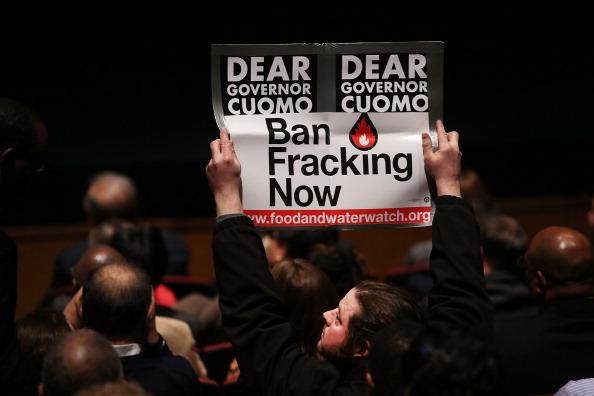 New York State continues to hold the decision on shale gas development in stalemate, provoking calls for more transparency in the process.
New York State continues to hold the decision on shale gas development in stalemate, provoking calls for more transparency in the process.
A decision on hydraulic fracturing in New York state has been in the works for several years. Former New York Governor David Paterson commissioned an Environmental Impact Study and Health Review in 2010, following the release of an initial EIS in 2009, in an effort to make an informed decision about whether to allow hydraulic fracturing in the state. A second draft Supplemental Generic Environmental Impact Study (SGEIS) was released in July of 2011, with an open comment period ending in January 2012.
The Department of Environmental Conservation (DEC) Commissioner Joseph Martens and Governor Andrew Cuomo announced in September 2012 that no decision would be made on hydraulic fracturing in New York State until a public health study on the practice was complete. The Department of Health has been working on this assessment for well over a year, and after initial deadlines were missed, there is no time frame for announcement of its conclusions.
This lack of forward momentum has prompted Assemblywoman Lupardo, a representative from the Binghamton area, to send a letter to Commissioner Martens requesting that the state impact assessment and health review of hydraulic fracturing be conducted in a more public way. The commissioner answered an earlier letter from Lupardo requesting that the advisory council on hydraulic fracturing be reconvened in order to move forward on this issue by saying that public health issues are outside of the purview of the committee. In her most recent letter, Lupardo states, “In order for the public to have confidence in the ‘health impact analysis’ of shale fracking, a comprehensive Public Health Impact Study should be undertaken openly and transparently to resolve all shale fracking concerns once and for all.” Commissioner Martens did not respond to a request for comment by the time of publication.
Research thus far on environmental and health impacts of hydraulic fracturing has been far from conclusive.
- A recent paper from Duke assessed the impacts of waste water effluent from fracking in western Pennsylvania. A Duke research group working on fracking led by Dr. Avner Vengosh concluded three things: first, that waste water from the Josephine Brine Treatment Facility, which processes Marcellus shale flowback water, had elevated salinity and traces of chloride and bromide; second, that the effluent had isotopic ratios reflecting some waste from hydraulic fracturing fluids specific to the Marcellus; and third, that there were elevated radium levels in stream sediment at the point of effluent release. According to Dr. Vengosh, “If this was waste water from another industry, the EPA would not allow this to happen”. Vengosh stated that in terms of capacity for waste water treatment, “all of these problems can be fixed, its just a matter of how much you are willing to invest. The technology is there to clean up even the fracking fluid.”
- The same Duke research group published a study in 2011 looking at methane contamination of shallow drinking water wells in areas surrounding active hydraulic fracturing sites in Northeastern Pennsylvania. The study found that there were elevated levels of dissolved methane in shallow drinking water sources within 1 km of active wells. The researchers linked this methane to hydraulic fracturing. While only covering a localized area, this study’s authors suggest that regulation to prevent methane contamination of drinking water surrounding hydraulic fracturing sites is needed.
- Earlier this year, a joint study by the Environmental Defense Fund (EDF) and UT Austin examined the issue of methane emissions at hydraulic fracturing sites. The study looked at 190 wells across the country and found that while emissions from completion of new wells were below EPA estimates, emissions from leaks and pneumatic controllers were higher than anticipated. According to the researchers, methane emissions from hydraulic fracturing sites fall within the EPA’s national emissions estimates.
- The EPA is conducting a long-term study of the potential impacts of hydraulic fracturing on drinking water, although no conclusive results have been published. This study looks at five areas of impact: water acquisition, chemical mixing of fracturing liquid, injection of fracturing fluid into production wells, flowback of fluid and produced water from the process, and waste water treatment and disposal. The release of preliminary findings at a site in Pavilion, Wyoming provoked much public debate and criticism of the EPA study, and the agency has since turned further investigation over to the state.
- The debate between Cabot Oil & Gas company and the residents of Dimock, Pennsylvania is one of the most publicized conflicts over hydraulic fracturing and contaminated drinking water claims. After complaints from residents and an initial settlement with Cabot, the EPA launched an official investigation into the contaminated drinking water claims. The agency found elevated levels of methane and a few other elements, but ultimately determined that the water was safe to drink. Subsequent release of EPA documents indicate possible dissent within the organization about this issue, but the data and conclusions remain unclear.
Even with all of the research being done on these issues, Dr. Vengosh told Breaking Energy that “we are really in the very early stages of understanding the impact [of hydraulic fracturing]”. He, like Lupardo and many of NY state’s politicians, feels that there is not enough information to make informed policy decision. “There is a huge gap between what we know and what we think we know.”
It remains unclear whether conclusions from these various studies will actually close that gap. Because the issue is so political, new scientific evidence might not sway decision makers.
